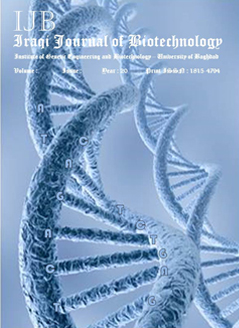Gene Number and Heredity of Yeild and Yeild Component of Maize
Abstract
A field experiment was conducted at the field of Crop Science Department, College of Agriculture – University of Baghdad during spring and fall seasons 2009-2010. Two maize inbreds; Nz25 and B73 were planted to produce single crosses hybrid, F2, F3, BC1, BC2, BC3 and BC4. The 9 genotypes were compared using RCBD with three replicates. The hybrid vigor for the single crosses and inbreeding depression for F2 , F3 ,BC1 and BC4,the variances of environment ,additive and dominance and the degree of dominance and heritability, number of genes were estimated ,for number of ears.plant-1(NE.P-1), number of row.ear-1(NRE ),number of grain.row-1(NGR), weight for 300 grain (gm)(GW), number grain.ear-1(NGE )and grain yield.plant-1(GY) . The experimental results showed significant differences in all characters. In this study, the highest hybrid vigor especially in GY.P-1 of 161.53%. There was a decline in the characters in F2 , F3 , BC1 and BC2 so that we cannot recommend to use seeds for commercial production. The dominance genetic variance was significantly superior in all characters in this study than the additive, which indicate that the genetic variance is very important in influencing the studied traits .The estimations of the average of degree of dominance were more than one for all the studied characters. The broad sense heritability was high which ranged from 0.656 in NE.P-1 to 0.978 for GW, while there is a decline in narrow sense heritability which indicates an important dominance genetic superiority in the studied characters. The number of genes which control NE.P-1 initiation was accede 5 pairs and 4 for the NKR.E-1 imitation 14 for NK.R-1 and 18 for theNK.E-1 and16 pairs for the GW and more than 34 pairs for the GY.P-1, all these results which indicate that these characters should be improved by crossing followed by selection , for they are quantitative traits.


